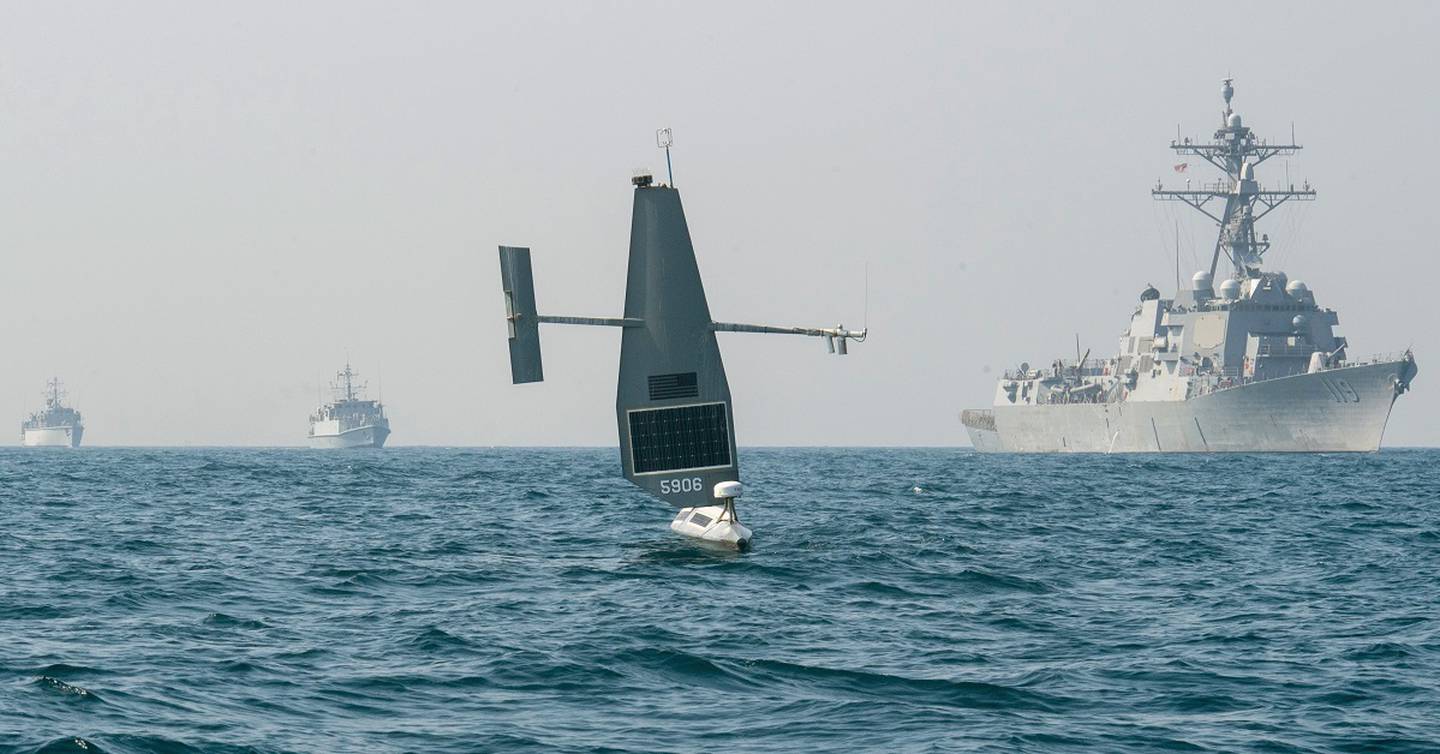WASHINGTON — The U.S. Navy and its partners in the Middle East are scaling up the number and the complexity of unmanned boats and artificial intelligence tools operating under Task Force 59, creating an extensive web that can flag unusual activity for human operators.
In fact, a year after the Bahrain-based U.S. 5th Fleet stood up Task Force 59 to boost maritime domain awareness in the crowded and vulnerable waterways, the Navy has built up a mesh network to connect its unmanned surface vessels and artificial intelligence tools with operators at a control center. And the Navy will add more systems to its inventory next month, 5th Fleet Vice Adm. Brad Cooper told reporters Oct. 12.
“Today in the Arabian Gulf, there’s about 8,000 ships that are underway doing something; there would be no human being that could possibly pick out that movement that’s outside the pattern of life. But what we’ve seen is AI can do it; it’s pretty accurate,” he said.
Task Force 59 was established in September 2021 to rapidly experiment with commercial unmanned and AI systems that could be integrated into naval operations in the Middle East. The task force staff works with industry and academia to further develop the technology. The staff also works with regional navies to incorporate this technology into real-world missions and take advantage of the intelligence and surveillance they generate. Manama, Bahrain, and Aqaba, Jordan, have been hubs for unmanned activity over the last year.
5th Fleet announced earlier this year its goal to form a multinational fleet of 100 USVs by next summer. Twenty would belong to the U.S., with the Navy leasing the USVs from industry but controlling their missions. Cooper declined to say how many are in the water today but said the U.S. would likely reach its 20-craft goal by next month. The other 80 would belong to regional partners.
Bahrain and Kuwait have already committed to buying USVs, he said, and other partners involved in Task Force 59 demonstrations could make commitments between now and the summer.
Task Force 59 led the International Maritime Exercise 2022 in February as an early demonstration of the power of USVs and AI tools working in concert. Cooper said the idea was to demonstrate to regional partners — Israel, Jordan, United Arab Emirates and more — how these tools could improve their coastal security more affordably than traditional manned patrol boats and frigates.
“It becomes really obvious when we begin to model this off of their own coast and they can see, wow, for pennies on the dollar we can put unmanned platforms out there, we can couple it with artificial intelligence … and then, I think critically important, we can use our manned ships much more efficiently, much more effectively,” he said.
Once Task Force 59 proved the usefulness of these USVs and AI tools, Cooper said there have been tight cycles of rapid improvements on the platforms and enabling technologies.
He did not discuss specific upgrades, but said the USVs — specifically the Saildrone Explorer that provides persistent maritime surveillance and the MARTAC Devil Ray T38 that provides a rapid response capability — have been tested, improved and then retested on 60- to 90-day cycles.

In an example of even more rapid iteration, Cooper said the U.S. built up a mesh network to share data in a communications-denied environment. This rudimentary network was tested at sea in an event with the U.S. and Saudi Arabia.
One week later, with help from industry, Task Force 59 enhanced this mesh network based on lessons learned and tested it again in an event with the U.S. and Jordan. A week later, the U.S. and Israel tested the next iteration. And a week later, the U.S. and NATO allies tested a further improved version in an exercise off Portugal, this time incorporating the Starlink satellite internet constellation.
Cooper said Starlink does not have coverage in the Middle East today, but a new satellite constellation should be up by next spring, meaning the broadband coverage could then be rapidly incorporated into the Task Force 59 mesh network.
The Navy has an overarching Unmanned Task Force at the Pentagon investigating where to make targeted technology maturation investments and the best acquisition methods for unmanned systems and the data they generate. Task Force 59 is a separate but related effort, and Cooper said everything his team is learning in 5th Fleet is applicable globally.
For example, he said a formation of USVs transited 2,000 miles over 200 days, from the northern shores of the Gulf of Aqaba down to the southern end of the Red Sea. That maneuver could be executed anywhere in any theater, Cooper said, and 5th Fleet has been working to translate it into a formal concept document.
However, that maneuver also has regional implications, and the Task Force 59 team is looking to understand what it means to have USVs cover that much ground in these waters, which not only see a significant amount of commercial shipping but also significant threats from weapons and drug trafficking, piracy and terrorism.
“It’s about 5,000 miles as you go around the Suez, all the way around the Arabian Peninsula to the North Arabian Gulf — so the waters are vast and highly dynamic,” Cooper said.
By embracing unmanned boats and AI tools, and the networks and cloud tools that connect them, the Navy and its partners will “expand our maritime domain awareness, which increases deterrence and allows you to better position yourself to respond if something does happen.”
Megan Eckstein is the naval warfare reporter at Defense News. She has covered military news since 2009, with a focus on U.S. Navy and Marine Corps operations, acquisition programs and budgets. She has reported from four geographic fleets and is happiest when she’s filing stories from a ship. Megan is a University of Maryland alumna.








